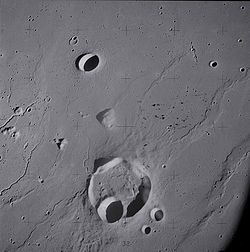Top Qs
Timeline
Chat
Perspective
Wrinkle ridge
Feature commonly found on lunar maria From Wikipedia, the free encyclopedia
Remove ads
A wrinkle ridge is a type of feature commonly found on lunar maria, or basalt plains. These features are low, sinuous ridges formed on the mare surface that can extend for up to several hundred kilometers. Wrinkle ridges are tectonic features created after the lava cooled and solidified. They frequently outline ring structures buried within the mare, follow circular patterns outlining the mare, or intersect protruding peaks. They are sometimes called veins due to their resemblance to the veins that protrude from beneath the skin.
This article includes a list of references, related reading, or external links, but its sources remain unclear because it lacks inline citations. (October 2018) |


Wrinkle ridges are named with the Latin designation dorsum (plural dorsa). The standard IAU nomenclature uses the names of people (generally scientists) to identify wrinkle ridges on the Moon. For example, the Dorsa Burnet are named for Thomas Burnet, and the Dorsum Owen is named after George Owen of Henllys.
Wrinkle ridges can also be found on Mars, for example in Chryse Planitia, on several of the asteroids that have been visited by spacecraft, on Mercury, and certain moons of Jupiter and Saturn. Although several hypotheses have been advanced as causes of wrinkle ridges, today they are generally considered to be of tectonic origin. They involve folding and faulting.[1] If correctly interpreted as thrust faults, where a rupture occurs and one side of the rupture is pushed on top of the other, they are evidence of compressional stress in planetary crust.[2]
Remove ads
Examples on the Moon
- Dorsum Zirkel in Mare Imbrium, from Apollo 15
- Oblique view of Dorsum Heim on the Moon, from Apollo 17
Examples on Mars
- Solis Dorsa are an expansive set of parallel wrinkle ridges on Solis Planum on Mars. Viking 1 Oribiter mosaic.
- Floor and eroded south wall of the crater Flaugergues on Mars. Arrows point to wrinkle ridges.
- Wrinkle ridges in Hesperia Planum, Mars, as seen by Viking. The wrinkle ridges trend in different directions, so compressional forces may have changed direction over time.
- Trough cutting a wrinkle ridge, as seen by HiRISE under HiWish program. Location in the Coprates quadrangle, Mars.
- Wrinkle ridge in the Oxia Colles region of Mars
Remove ads
Examples on Mercury
- Antoniadi Dorsum cuts across the crater Geddes.
- The prominent wrinkle ridge across the center is Schiaparelli Dorsum.
See also
References
Notes
Wikiwand - on
Seamless Wikipedia browsing. On steroids.
Remove ads











